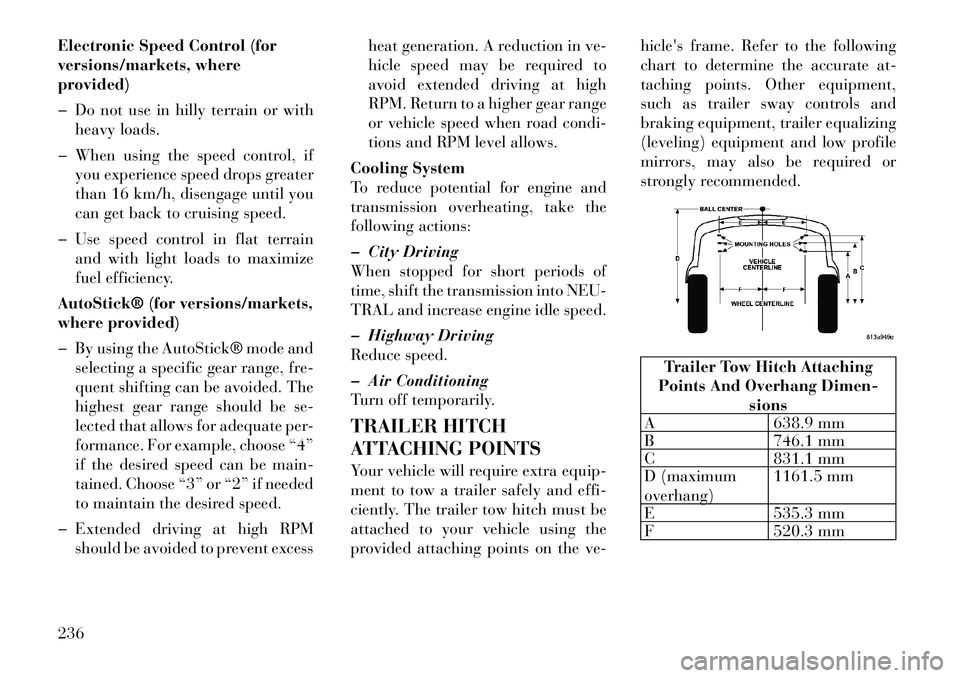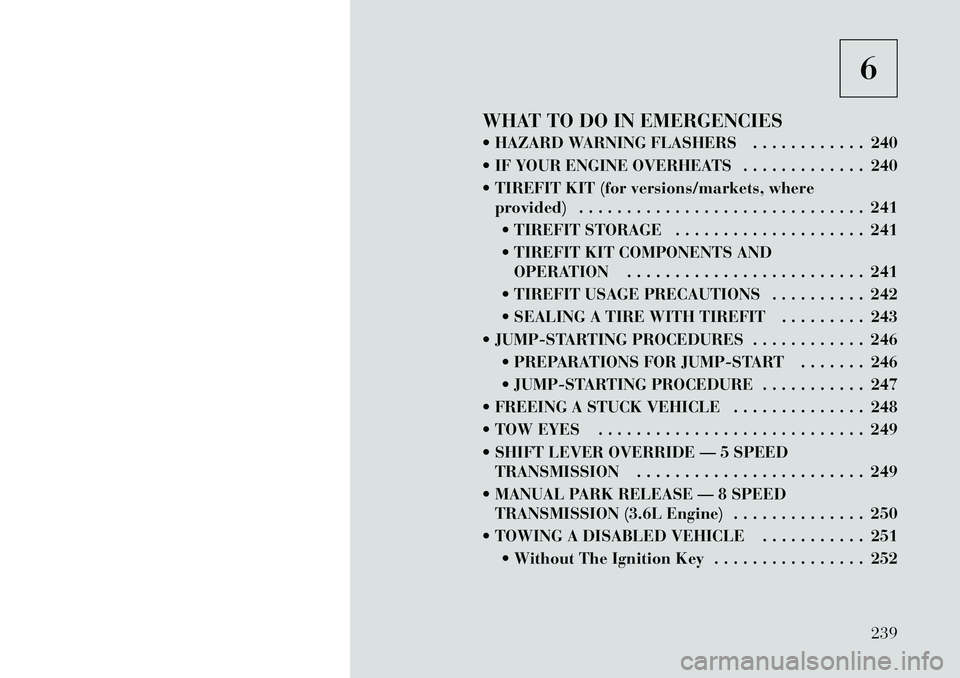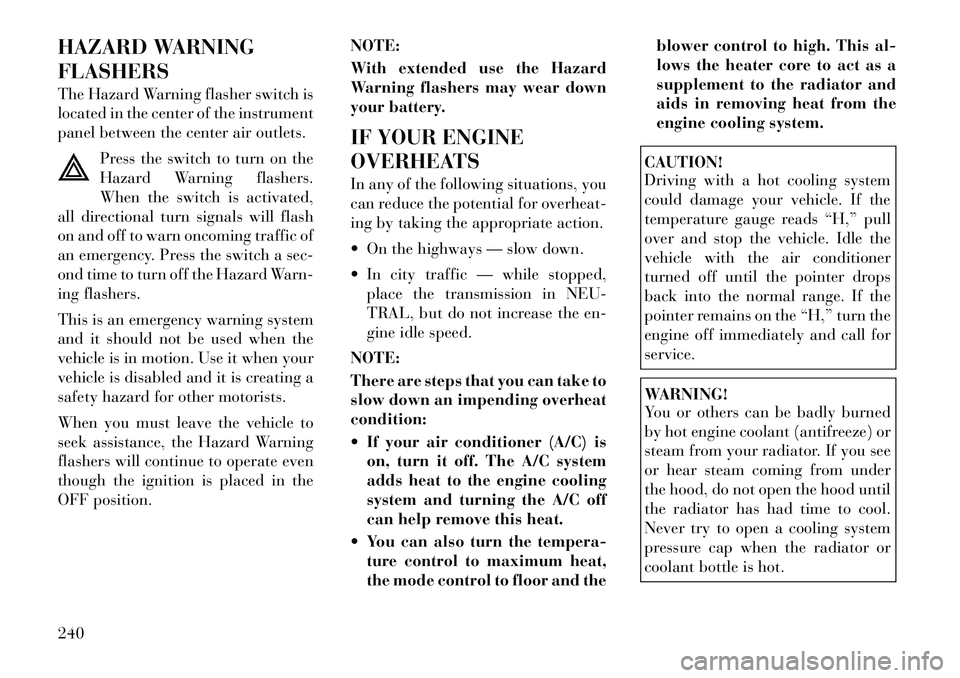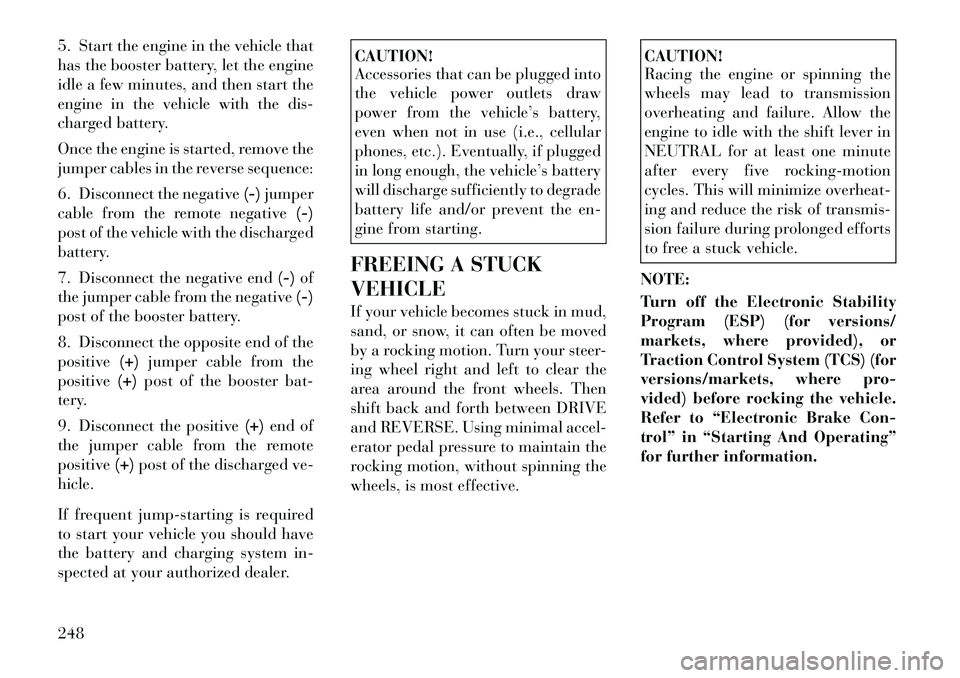engine Lancia Thema 2012 Owner handbook (in English)
[x] Cancel search | Manufacturer: LANCIA, Model Year: 2012, Model line: Thema, Model: Lancia Thema 2012Pages: 316, PDF Size: 3.85 MB
Page 237 of 316

TRAILER TOWING WEIGHTS (MAXIMUM TRAILER WEIGHT RATINGS)
The following chart provides the maximum trailer weight ratings towable for your given drivetrain.
Engine/TransmissionFrontal AreaMax. GTW
(Gross Trailer Wt.) Max. Tongue Wt.
(See Note)
3.6L Automatic 2.04 sq m1 725 kg 86 kg
3.0L Diesel Automatic 2.97 sq m1 996 kg 100 kg
Refer to local laws for maximum trailer towing speeds
NOTE: The trailer tongue weight must be considered as part of the combined weight of occupants and cargo,
and it should never exceed the weight referenced on the “Tire and Loading Information” placard. Refer to
“Tire Safety Information” in “Starting and Operating” for further information.
TRAILER AND TONGUE
WEIGHT
Always load a trailer with 60% to
65% of the weight in the front of the
trailer. This places 5% of the Gross
Trailer Weight (GTW) on the tow
hitch of your vehicle. Loads balanced
over the wheels or heavier in the rear
can cause the trailer to sway severely
side to side which will cause loss of
control of the vehicle and trailer. Fail-
ure to load trailers heavier in front is
the cause of many trailer collisions.
Never exceed the maximum tongue
weight stamped on your bumper or
trailer hitch. Consider the following items when
computing the weight on the rear axle
of the vehicle:
The tongue weight of the trailer.
The weight of any other type of
cargo or equipment put in or on
your vehicle. The weight of the driver and all
passengers.
NOTE:
Remember that everything put into
or on the trailer adds to the load on
your vehicle. Also, additional
factory-installed options or
dealer-installed options must be
considered as part of the total load
on your vehicle. Refer to the “Tire
and Loading Information” placard
for the maximum combined weight
of occupants and cargo for your
vehicle.
231
Page 238 of 316

TOWING REQUIREMENTS
To promote proper break-in of your
new vehicle drivetrain components
the following guidelines are recom-
mended:CAUTION!
Do not tow a trailer at all duringthe first 805 km the new vehicle is
driven. The engine, axle or other
parts could be damaged.
Then, during the first 805 km that
a trailer is towed, do not drive
over 80 km/h and do not make
starts at full throttle. This helps
the engine and other parts of the
vehicle wear in at the heavier
loads.WARNING!
Improper towing can lead to an in-
jury collision. Follow these guide-
lines to make your trailer towing as
safe as possible:
(Continued)
WARNING!(Continued)
Make certain that the load is se-
cured in the trailer and it will not
shift during travel. When traile-
ring cargo that is not fully se-
cured, dynamic load shifts can oc-
cur that may be difficult for the
driver to control. You could lose
control of your vehicle and have a
collision.
When hauling cargo or towing a
trailer, do not overload your ve-
hicle or trailer. Overloading can
cause a loss of control, poor per-
formance, or damage to brakes,
axle, engine, transmission, steer-
ing, suspension, chassis structure,
or tires.
Safety chains must always be used
between your vehicle and trailer.
Always connect the chains to the
frame or hook retainers of the ve-
hicle hitch. Cross the chains under
the trailer tongue and allow
enough slack for turning corners.
(Continued)
WARNING!(Continued)
Vehicles with trailers should not
be parked on a grade. When park-
ing, apply the parking brake on
the tow vehicle. Put the tow ve-
hicle automatic transmission in
PARK. Always, block or "chock"
the trailer wheels.
GCWR must not be exceeded.
Total weight must be distrib-
uted between the tow vehicle
and the trailer such that the
following four ratings are not
exceeded:
1. Max loading as defined on the
“Tire and Loading Information”
placard.
2. GTW
3. GAWR
4. Tongue weight rating for the
trailer hitch utilized. (This require-
ment may limit the ability to always
achieve the 10% to 15% range of
tongue weight as a percentage of
total trailer weight.)
Towing Requirements – Tires
� Do not attempt to tow a trailer while using a compact spare tire.
232
Page 241 of 316

Pin
Number Function Wire
Color
5 Right Rear
Position, SideMarker
Lights, and
Rear Registra- tion Plate
Illumination
Device.
b
Brown
6 Stoplights Red
7 Left Rear Position, SideMarker
Lights, and
Rear Registra-
tion Plate
Illumination Device.
b
Black
8 Reverse lights Red/ Black
9 Permanent
Power Supply(+12V) Brown/
White
10 Power Supply Controlled byIgnition
Switch
(+12V) Red
Pin
Number Function Wire
Color
11
a
Return for
Contact (Pin) 10 White
12 Reserve for Future Alloca-
tion Red/Blue
13
a
Return for
Contact (Pin) 9 White
Note: The allocation pin 12 has
been changed from “Coding for
coupled Trailer” to “Reserve for
Future Allocation.”
aThe three return circuits shall not
be connected electrically in the
trailer.bThe rear position registration
plate illumination device shall be
connected such that no light of the
device has a common connection
with both pins 5 and 7.
TOWING TIPS
Before setting out on a trip, practice
turning, stopping, and backing up the
trailer in an area located away from
heavy traffic. Automatic Transmission
The DRIVE range can be selected
when towing. However, if frequent
shifting occurs while in this range,
select a lower gear range using the
AutoStick® shift control (for
versions/markets, where provided).
NOTE:
Selecting a lower gear range while
operating the vehicle under heavy
operating conditions will improve
performance and extend transmis-
sion life by reducing excessive
shifting and heat buildup. This ac-
tion will also provide better engine
braking.
If you REGULARLY tow a trailer for
more than 45 minutes of continuous
operation, then change the automatic
transmission fluid and filter accord-
ing to the interval specified for “po-
lice, taxi, fleet, or frequent trailer tow-
ing.” Refer to the “Maintenance
Schedule” for the proper maintenance
intervals.
235
Page 242 of 316

Electronic Speed Control (for
versions/markets, where
provided)
� Do not use in hilly terrain or withheavy loads.
� When using the speed control, if you experience speed drops greater
than 16 km/h, disengage until you
can get back to cruising speed.
� Use speed control in flat terrain and with light loads to maximize
fuel efficiency.
AutoStick® (for versions/markets,
where provided)
� By using the AutoStick® mode and selecting a specific gear range, fr e-
quent shifting can be avoided. The
highest gear range should be se-
lected that allows for adequate per-
formance. For example, choose “4”
if the desired speed can be main-
tained. Choose “3” or “2” if needed
to maintain the desired speed.
� Extended driving at high RPM should be avoided to prevent excess heat generation. A reduction in
ve-
hicle speed may be required to
avoid extended driving at high
RPM. Return to a higher gear range
or vehicle speed when road condi-
tions and RPM level allows.
Cooling System
To reduce potential for engine and
transmission overheating, take the
following actions:
� City Driving
When stopped for short periods of
time, shift the transmission into NEU-
TRAL and increase engine idle speed.
� Highway Driving
Reduce speed.
� Air Conditioning
Turn off temporarily.
TRAILER HITCH
ATTACHING POINTS
Your vehicle will require extra equip-
ment to tow a trailer safely and effi-
ciently. The trailer tow hitch must be
attached to your vehicle using the
provided attaching points on the ve- hicle's frame. Refer to the following
chart to determine the accurate
at-
taching points. Other equipment,
such as trailer sway controls and
braking equipment, trailer equalizing
(leveling) equipment and low profile
mirrors, may also be required or
strongly recommended.
Trailer Tow Hitch Attaching
Points And Overhang Dimen- sions
A 638.9 mm
B 746.1 mm
C 831.1 mm
D (maximum
overhang) 1161.5 mm
E 535.3 mm
F 520.3 mm
236
Page 245 of 316

6
WHAT TO DO IN EMERGENCIES
HAZARD WARNING FLASHERS . . . . . . . . . . . . 240
IF YOUR ENGINE OVERHEATS . . . . . . . . . . . . . 240
TIREFIT KIT (for versions/markets, where provided) . . . . . . . . . . . . . . . . . . . . . . . . . . . . . . 241
TIREFIT STORAGE . . . . . . . . . . . . . . . . . . . . 241
TIREFIT KIT COMPONENTS AND OPERATION . . . . . . . . . . . . . . . . . . . . . . . . . 241
TIREFIT USAGE PRECAUTIONS . . . . . . . . . . 242
SEALING A TIRE WITH TIREFIT . . . . . . . . . 243
JUMP-STARTING PROCEDURES . . . . . . . . . . . . 246 PREPARATIONS FOR JUMP-START . . . . . . . 246
JUMP-STARTING PROCEDURE . . . . . . . . . . . 247
FREEING A STUCK VEHICLE . . . . . . . . . . . . . . 248
TOW EYES . . . . . . . . . . . . . . . . . . . . . . . . . . . . 249
SHIFT LEVER OVERRIDE — 5 SPEED TRANSMISSION . . . . . . . . . . . . . . . . . . . . . . . . 249
MANUAL PARK RELEASE — 8 SPEED TRANSMISSION (3.6L Engine) . . . . . . . . . . . . . . 250
TOWING A DISABLED VEHICLE . . . . . . . . . . . 251 Without The Ignition Key . . . . . . . . . . . . . . . . 252
239
Page 246 of 316

HAZARD WARNING
FLASHERS
The Hazard Warning flasher switch is
located in the center of the instrument
panel between the center air outlets.Press the switch to turn on the
Hazard Warning flashers.
When the switch is activated,
all directional turn signals will flash
on and off to warn oncoming traffic of
an emergency. Press the switch a sec-
ond time to turn off the Hazard Warn-
ing flashers.
This is an emergency warning system
and it should not be used when the
vehicle is in motion. Use it when your
vehicle is disabled and it is creating a
safety hazard for other motorists.
When you must leave the vehicle to
seek assistance, the Hazard Warning
flashers will continue to operate even
though the ignition is placed in the
OFF position. NOTE:
With extended use the Hazard
Warning flashers may wear down
your battery.
IF YOUR ENGINE
OVERHEATS
In any of the following situations, you
can reduce the potential for overheat-
ing by taking the appropriate action.
On the highways — slow down.
In city traffic — while stopped,
place the transmission in NEU-
TRAL, but do not increase the en-
gine idle speed.
NOTE:
There are steps that you can take to
slow down an impending overheat
condition:
If your air conditioner (A/C) is on, turn it off. The A/C system
adds heat to the engine cooling
system and turning the A/C off
can help remove this heat.
You can also turn the tempera- ture control to maximum heat,
the mode control to floor and the blower control to high. This al-
lows the heater core to act as a
supplement to the radiator and
aids in removing heat from the
engine cooling system.
CAUTION!
Driving with a hot cooling system
could damage your vehicle. If the
temperature gauge reads “H,” pull
over and stop the vehicle. Idle the
vehicle with the air conditioner
turned off until the pointer drops
back into the normal range. If the
pointer remains on the “H,” turn the
engine off immediately and call for
service.WARNING!
You or others can be badly burned
by hot engine coolant (antifreeze) or
steam from your radiator. If you see
or hear steam coming from under
the hood, do not open the hood until
the radiator has had time to cool.
Never try to open a cooling system
pressure cap when the radiator or
coolant bottle is hot.
240
Page 249 of 316

WARNING!(Continued)
Take care not to allow the con-
tents of TIREFIT to come in con-
tact with hair, eyes, or clothing.
TIREFIT is harmful if inhaled,
swallowed, or absorbed through
the skin. It causes skin, eye, and
respiratory irritation. Flush im-
mediately with plenty of water if
there is any contact with eyes or
skin. Change clothing as soon as
possible, if there is any contact
with clothing.
TIREFIT Sealant solution con-
tains latex. In case of an allergic
reaction or rash, consult a physi-
cian immediately. Keep TIREFIT
out of reach of children. If swal-
lowed, rinse mouth immediately
with plenty of water and drink
plenty of water. Do not induce
vomiting! Consult a physician im-
mediately. SEALING A TIRE WITH
TIREFIT
(A) Whenever You Stop To Use
TIREFIT:
1. Pull over to a safe location and
turn on the vehicle’s Hazard Warning
flashers.
2. Verify that the valve stem (on the
wheel with the deflated tire) is in a
position that is near to the ground.
This will allow the TIREFIT Hoses
(6) and (7) to reach the valve stem
and keep the TIREFIT kit flat on the
ground. This will provide the best po-
sitioning of the kit when injecting the
sealant into the deflated tire and run-
ning the air pump. Move the vehicle as
necessary to place the valve stem in
this position before proceeding.
3. Place the transmission in PARK
(auto transmission) or in Gear
(manual transmission) and turn Off
the ignition.
4. Set the parking brake.
(B) Setting Up To Use TIREFIT:
1. Turn the Mode Select Knob (5) to
the Sealant Mode position. 2. Uncoil the Sealant Hose (6) and
then remove the cap from the fitting
at the end of the hose.
3. Place the TIREFIT kit flat on the
ground next to the deflated tire.
4. Remove the cap from the valve
stem and then screw the fitting at the
end of the Sealant Hose (6) onto the
valve stem.
5. Uncoil the Power Plug (8) and in-
sert the plug into the vehicle’s 12 Volt
power outlet.
NOTE:
Do not remove foreign objects (e.g.,
screws or nails) from the tire.
(C) Injecting TIREFIT Sealant
Into The Deflated Tire:
Always start the engine before
turning ON the TIREFIT kit.
NOTE:
Manual transmission vehicles
must have the parking brake en-
gaged and the shift lever in NEU-
TRAL.
After pressing the Power Button (4), the sealant (white fluid) will
243
Page 250 of 316

flow from the Sealant Bottle (1)
through the Sealant Hose (6) and
into the tire.
NOTE:
Sealant may leak out through the
puncture in the tire.
If the sealant (white fluid) does not
flow within 0 – 10 seconds through
the Sealant Hose (6):
1. Press the Power Button (4) to turn
Off the TIREFIT kit. Disconnect the
Sealant Hose (6) from the valve stem.
Make sure the valve stem is free of
debris. Reconnect the Sealant Hose
(6) to the valve stem. Check that the
Mode Select Knob (5) is in the Sealant
Mode position and not Air Mode.
Press the Power Button (4) to turn On
the TIREFIT kit.
2. Connect the Power Plug (8) to a
different 12 Volt power outlet in your
vehicle or another vehicle, if avail-
able. Make sure the engine is running
before turning ON the TIREFIT kit.
3. The Sealant Bottle (1) may be
empty due to previous use. Call for
assistance. NOTE:
If the Mode Select Knob (5) is on
Air Mode and the pump is operat-
ing, air will dispense from the Air
Pump Hose (7) only, not the Seal-
ant Hose (6).
If the sealant (white fluid) does
flow
through the Sealant Hose (6):
1. Continue to operate the pump un-
til sealant is no longer flowing
through hose (typically takes 30 -
70 seconds). As the sealant flows
through the Sealant Hose (6), the
Pressure Gauge (3) can read as high
as 5 Bar. The Pressure Gauge (3) will
decrease quickly from approximately
70 psi (5 Bar) to the actual tire pres-
sure when the Sealant Bottle (1) is
empty.
2. The pump will start to inject air
into the tire immediately after the
Sealant Bottle (1) is empty. Continue
to operate the pump and inflate the
tire to the pressure indicated on the
tire pressure label on the driver-side
latch pillar (recommended pressure).
Check the tire pressure by looking at
the Pressure Gauge (3). If the tire does not inflate to at least
1.8 Bar pressure within 15 min-
utes:
The tire is too badly damaged. Do
not attempt to drive the vehicle fur-
ther. Call for assistance.
NOTE:
If the tire becomes over-inflated,
press the Deflation Button to re-
duce the tire pressure to the rec-
ommended inflation pressure be-
fore continuing.
If the tire inflates to the recom-
mended pressure or is at least 1.8
Bar pressure within 15 minutes:
1. Press the Power Button (4) to turn
off the TIREFIT kit.
2. Remove the Speed Limit sticker
from the top of the Sealant Bottle (1)
and place the sticker on the instru-
ment panel.
3. Immediately disconnect the Seal-
ant Hose (6) from the valve stem,
reinstall the cap on the fitting at the
end of the hose, and place the TIRE-
244
Page 252 of 316

5. Replace the Sealant Bottle (1) and
Sealant Hose (6) assembly at your
authorized dealer as soon as possible.
Refer to “(F) Sealant Bottle and Hose
Replacement.”
NOTE:
When having the tire serviced, ad-
vise the authorized dealer or ser-
vice center that the tire has been
sealed using the TIREFIT service
kit.
(F) Sealant Bottle And Hose
Replacement:
1. Uncoil the Sealant Hose (6) (clear
in color).
2. Locate the round Sealant Bottle
release button in the recessed area
under the sealant bottle.
3. Press the Sealant Bottle release
button. The Sealant Bottle (1) will
pop up. Remove the bottle and dis-
pose of it accordingly.
4. Clean any remaining sealant from
the TIREFIT housing.
5. Position the new Sealant Bottle (1)
in the housing so that the Sealant
Hose (6) aligns with the hose slot inthe front of the housing. Press the
bottle into the housing. An audible
click will be heard indicating the
bottle is locked into place.
6. Verify that the cap is installed on
the fitting at the end of the Sealant
Hose (6) and return the hose to its
storage area (located on the bottom of
the air pump).
7. Return the TIREFIT kit to its stor-
age location in the vehicle.
JUMP-STARTING
PROCEDURES
If your vehicle has a discharged bat-
tery it can be jump-started using a set
of jumper cables and a battery in an-
other vehicle or by using a portable
battery booster pack. Jump-starting
can be dangerous if done improperly
so please follow the procedures in this
section carefully.
NOTE:
When using a portable battery
booster pack follow the manufac-
turer’s operating instructions and
precautions.
CAUTION!
Do not use a portable battery
booster pack or any other booster
source with a system voltage greater
than 12 Volts or damage to the bat-
tery, starter motor, alternator or
electrical system may occur.WARNING!
Do not attempt jump-starting if the
battery is frozen. It could rupture or
explode and cause personal injury.
PREPARATIONS FOR
JUMP-START
The battery is stored under an access
cover in the trunk. Remote battery
posts are located on the right side of
the engine compartment for jump-
starting.
NOTE:
The remote battery posts are
viewed by standing on the right
side of the vehicle looking over the
fender.
246
Page 254 of 316

5. Start the engine in the vehicle that
has the booster battery, let the engine
idle a few minutes, and then start the
engine in the vehicle with the dis-
charged battery.
Once the engine is started, remove the
jumper cables in the reverse sequence:
6. Disconnect the negative(-)jumper
cable from the remote negative (-)
post of the vehicle with the discharged
battery.
7. Disconnect the negative end (-)of
the jumper cable from the negative (-)
post of the booster battery.
8. Disconnect the opposite end of the
positive (+)jumper cable from the
positive (+)post of the booster bat-
tery.
9. Disconnect the positive (+)end of
the jumper cable from the remote
positive (+)post of the discharged ve-
hicle.
If frequent jump-starting is required
to start your vehicle you should have
the battery and charging system in-
spected at your authorized dealer.
CAUTION!
Accessories that can be plugged into
the vehicle power outlets draw
power from the vehicle’s battery,
even when not in use (i.e., cellular
phones, etc.). Eventually, if plugged
in long enough, the vehicle’s battery
will discharge sufficiently to degrade
battery life and/or prevent the en-
gine from starting.
FREEING A STUCK
VEHICLE
If your vehicle becomes stuck in mud,
sand, or snow, it can often be moved
by a rocking motion. Turn your steer-
ing wheel right and left to clear the
area around the front wheels. Then
shift back and forth between DRIVE
and REVERSE. Using minimal accel-
erator pedal pressure to maintain the
rocking motion, without spinning the
wheels, is most effective.
CAUTION!
Racing the engine or spinning the
wheels may lead to transmission
overheating and failure. Allow the
engine to idle with the shift lever in
NEUTRAL for at least one minute
after every five rocking-motion
cycles. This will minimize overheat-
ing and reduce the risk of transmis-
sion failure during prolonged efforts
to free a stuck vehicle.
NOTE:
Turn off the Electronic Stability
Program (ESP) (for versions/
markets, where provided), or
Traction Control System (TCS) (for
versions/markets, where pro-
vided) before rocking the vehicle.
Refer to “Electronic Brake Con-
trol” in “Starting And Operating”
for further information.
248